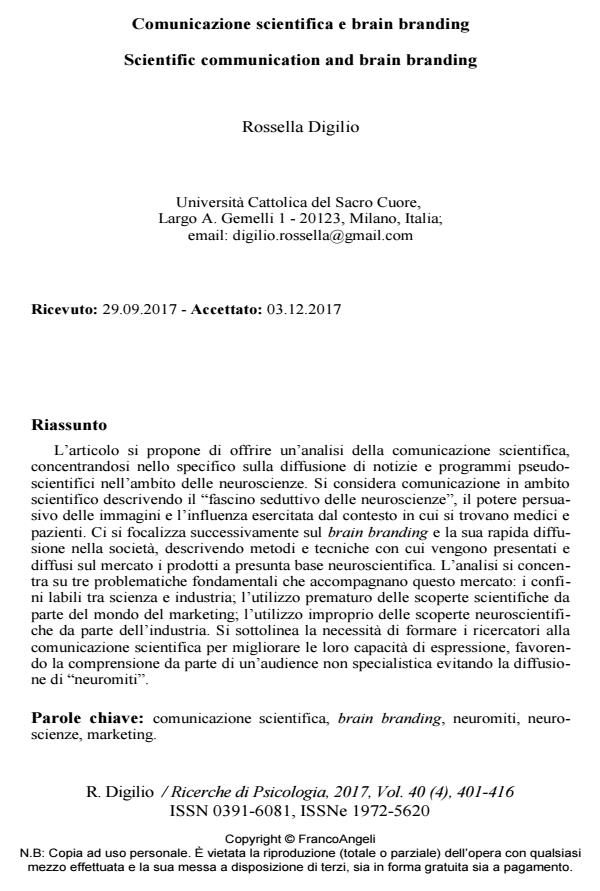Comunicazione scientifica e brain branding
Titolo Rivista RICERCHE DI PSICOLOGIA
Autori/Curatori Rossella Digilio
Anno di pubblicazione 2017 Fascicolo 2017/4
Lingua Italiano Numero pagine 16 P. 401-416 Dimensione file 206 KB
DOI 10.3280/RIP2017-004002
Il DOI è il codice a barre della proprietà intellettuale: per saperne di più
clicca qui
Qui sotto puoi vedere in anteprima la prima pagina di questo articolo.
Se questo articolo ti interessa, lo puoi acquistare (e scaricare in formato pdf) seguendo le facili indicazioni per acquistare il download credit. Acquista Download Credits per scaricare questo Articolo in formato PDF

FrancoAngeli è membro della Publishers International Linking Association, Inc (PILA)associazione indipendente e non profit per facilitare (attraverso i servizi tecnologici implementati da CrossRef.org) l’accesso degli studiosi ai contenuti digitali nelle pubblicazioni professionali e scientifiche
L’articolo si propone di offrire un’analisi della comunicazione scientifica, concentrandosi nello specifico sulla diffusione di notizie e programmi pseudoscientifici nell’ambito delle neuroscienze. Si considera comunicazione in ambito scientifico descrivendo il "fascino seduttivo delle neuroscienze", il potere persuasivo delle immagini e l’influenza esercitata dal contesto in cui si trovano medici e pazienti. Ci si focalizza successivamente sul brain branding e la sua rapida diffusione nella società, descrivendo metodi e tecniche con cui vengono presentati e diffusi sul mercato i prodotti a presunta base neuroscientifica. L’analisi si concentra su tre problematiche fondamentali che accompagnano questo mercato: i confini labili tra scienza e industria; l’utilizzo prematuro delle scoperte scientifiche da parte del mondo del marketing; l’utilizzo improprio delle scoperte neuroscientifiche da parte dell’industria. Si sottolinea la necessità di formare i ricercatori alla comunicazione scientifica per migliorare le loro capacità di espressione, favorendo la comprensione da parte di un’audience non specialistica evitando la diffusione di "neuromiti".
Parole chiave:Comunicazione scientifica, brain branding, neuromiti, neuroscienze, marketing.
- Neurodidactics of Languages: Neuromyths in Multilingual Learners Antonia Navarro Rincón, María José Carrillo López, César Augusto Solano Galvis, Laura Isla Navarro, in Mathematics /2022 pp.196
DOI: 10.3390/math10020196
Rossella Digilio, Comunicazione scientifica e brain branding in "RICERCHE DI PSICOLOGIA " 4/2017, pp 401-416, DOI: 10.3280/RIP2017-004002